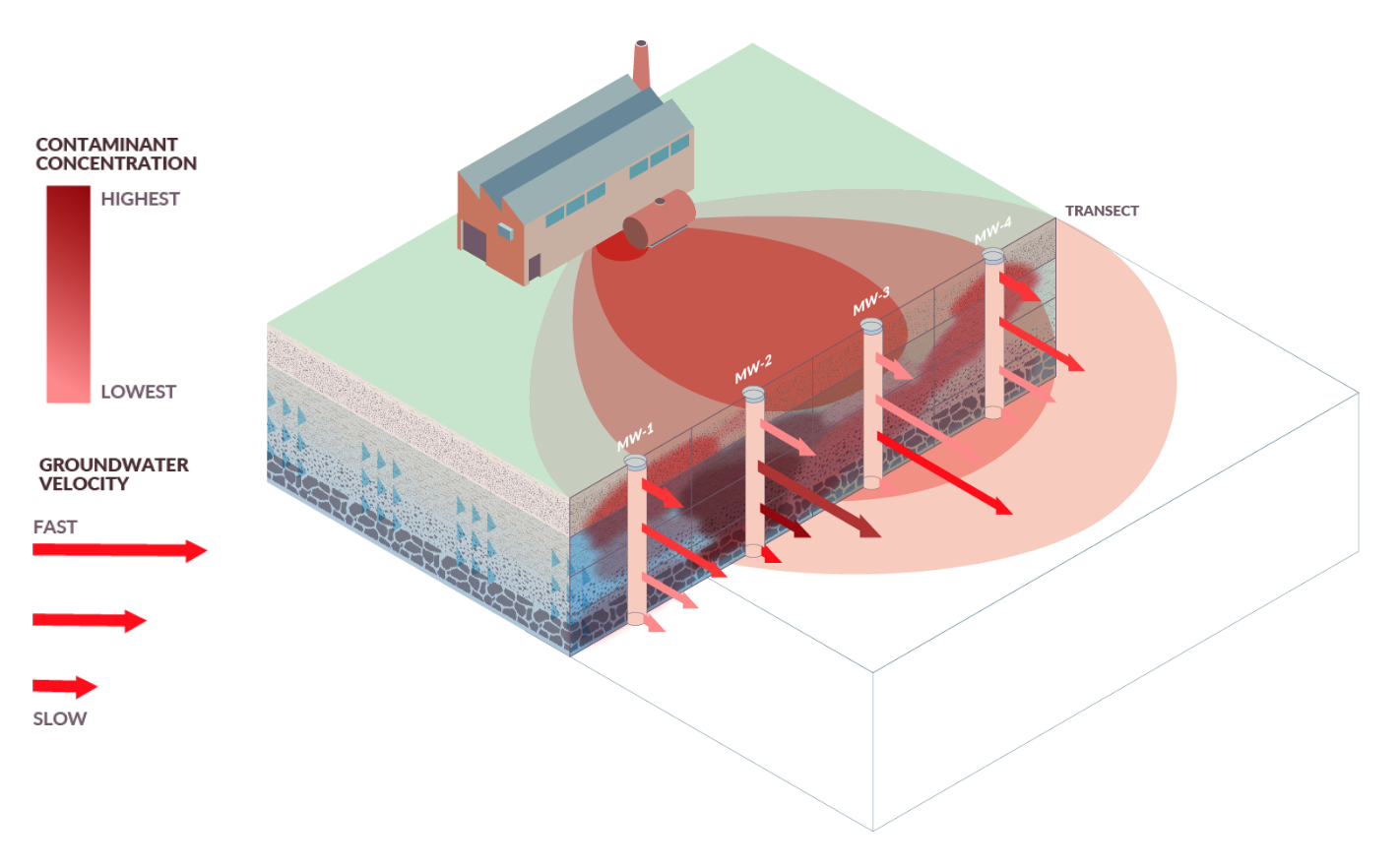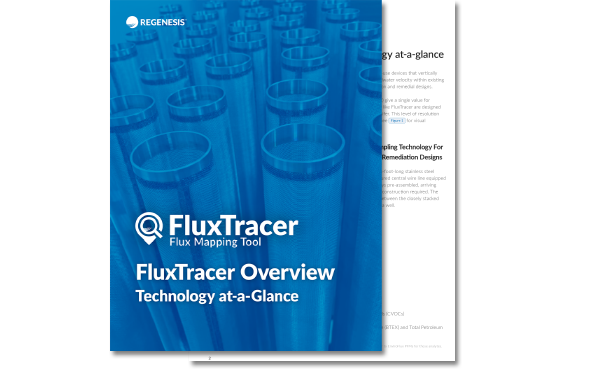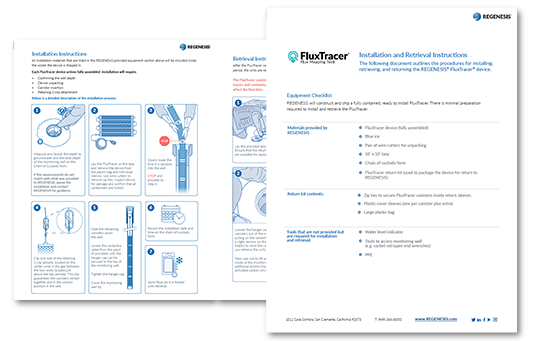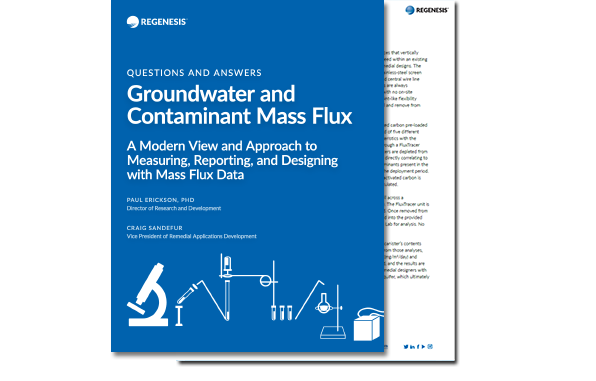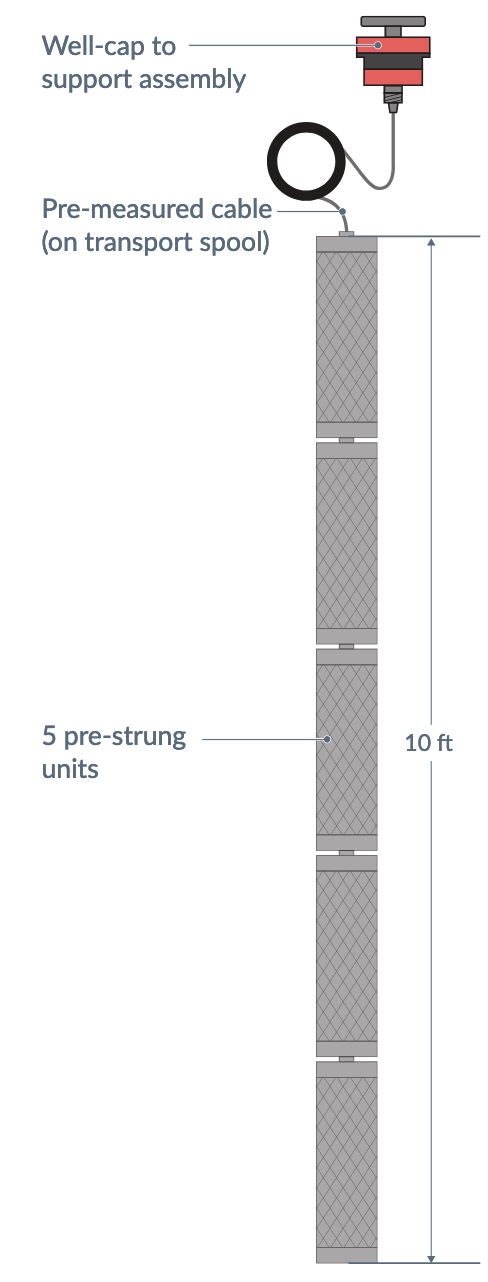
FluxTracer: Technology at-a-glance
FluxTracer® Flux Mapping Tools are easy-to-use devices that vertically delineate contaminant mass flux and groundwater velocity within existing monitoring wells to aid in site characterization and remedial designs. Conventional methods (pump and slug tests) give a single value for groundwater velocity whereas passive tools like FluxTracer are designed to distinguish individual zones within an aquifer. This level of resolution is especially useful for remediation design.
Easy-to-use devices that vertically delineate contaminant mass flux and groundwater speed within an existing monitoring well to aid in site characterization and remedial designs. The FluxTracers consist of five separate two-foot-long stainless-steel screen canisters that are secured in series on a pre-measured central wire line equipped with a modified J-Plug well cap. FluxTracers are always pre-assembled, arriving at your site ready to deploy with no on-site construction required.
Key Benefits:
- High Data Resolution and Accuracy
- Plume Characterization
- Estimate In Situ Product Longevity
- Reliable Turnaround Time
- Affordable with Full Customer Support
Fast Installation:
- 15-Minute Install Per Device
- Ready to Deploy Upon Arrival
- No Assembly Required
Target Contaminants:
- Chlorinated Volatile Organic Compounds (CVOCs)
PFAS - Benzene, Toluene, Ethylbenzene, Xylene (BTEX) and Total Petroleum
- Hydrocarbons (TPH) (PFM)*
* Analysis for BTEX and TPH are in development. Please refer to EnviroFlux PFMs for these analytes.
What is Mass Flux?
Mass flux is defined as the contaminant mass moving across a unit area (aquifer) perpendicular to the groundwater flow direction. Mass flux is measured as mass/area/time.
How To Order
Step 1
Contact Us
Need more assistance on evaluating your site for FluxTracer placement? Reach out to our sales and technical services team to chat.
Step 2
Eval Form
Download and fill out the FluxTracer Evaluation Form. That gives us exactly what we need to build your device per your wells’ specification and ship it to your desired location.
Step 3
Official Quote
Need an official quote to include shipping price? Reach out to our sales team to have an official quote sent to you.
Step 4
Sales Agreement
Lastly sign our Sales Order Agreement to officially lock in your order and shipment date. Upon signed SOA, your FluxTracer order is places in queue and will be on your way!
How FluxTracer Works
Each FluxTracer canister is filled with granular activated carbon pre-loaded with biodegradable tracers. The tracers are composed of five different alcohols each having well-known partitioning characteristics with the activated carbon. As groundwater passively flows through a FluxTracer canister over the deployment period, the alcohol tracers are depleted from the activated carbon, with the net loss of the tracers directly correlating to the groundwater velocity. At the same time, any contaminants present in the groundwater adsorb to the activated carbon during the deployment period. The total mass of contaminants accumulated on the activated carbon is then quantified and the contaminant mass flux is calculated.
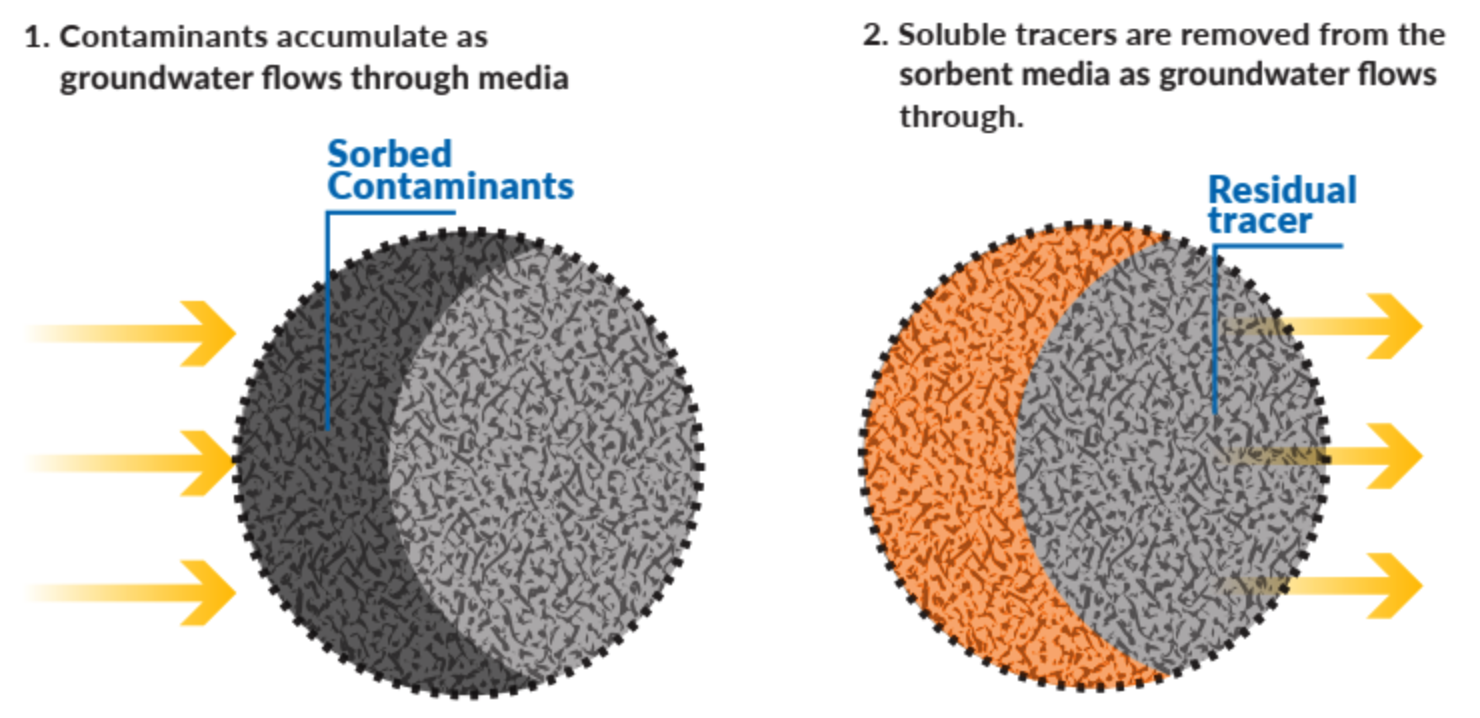
Oftentimes 90% of contaminant mass is moving through 10% of the aquifier
Figure 1: Measuring Groundwater Velocity & Mass Flux: Data Comparison
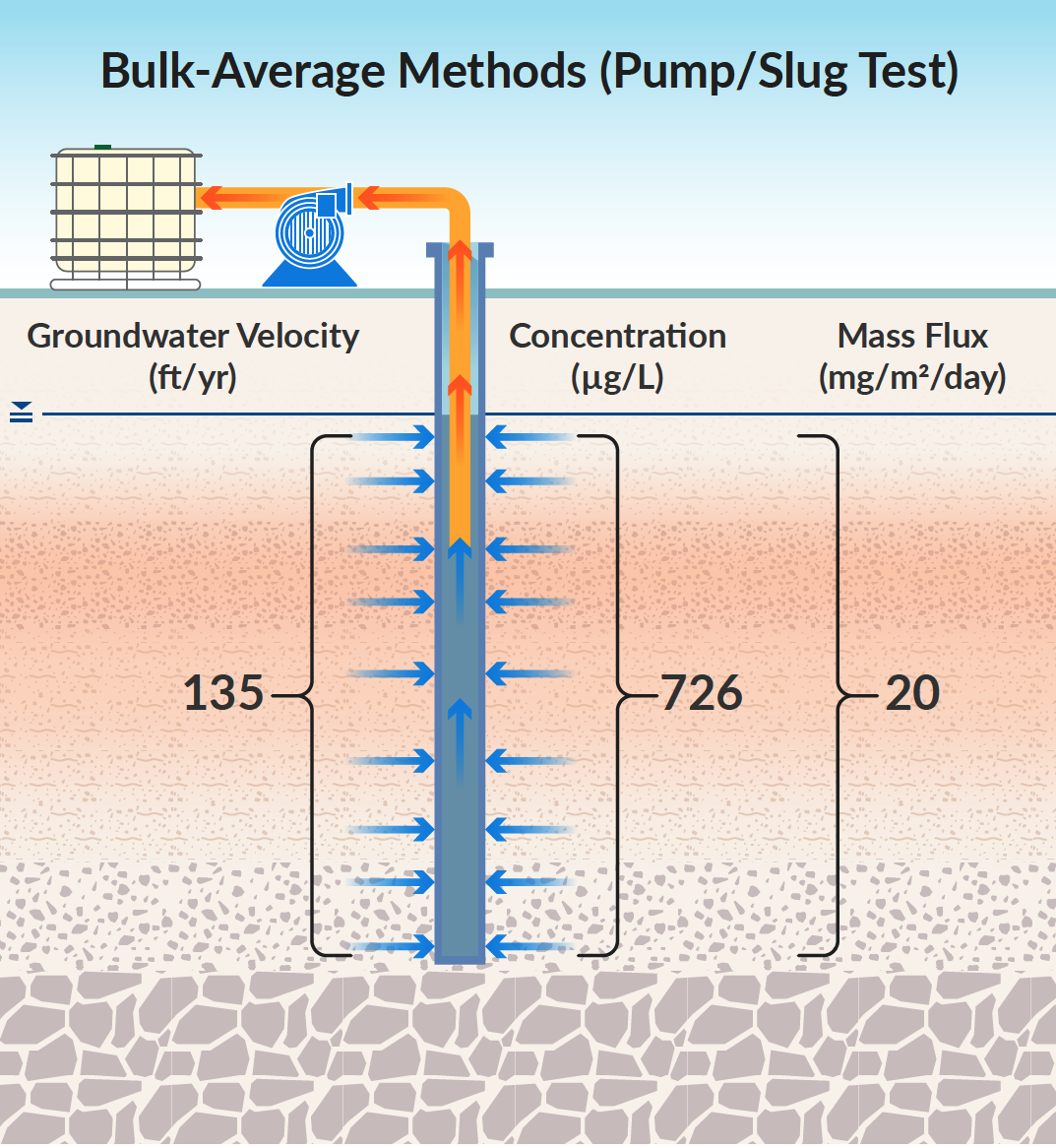
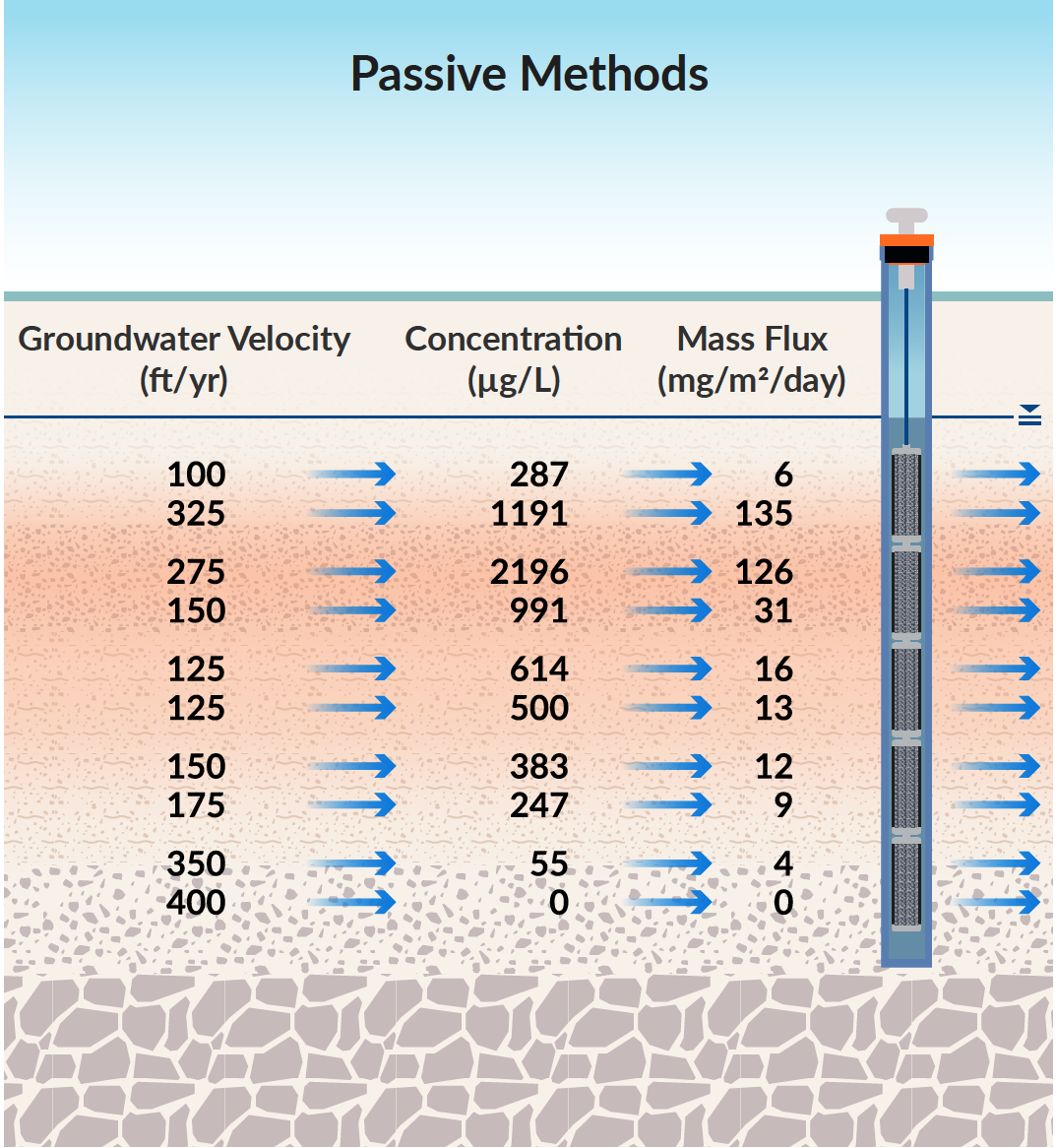
Figure 2: Conceptual Site Model
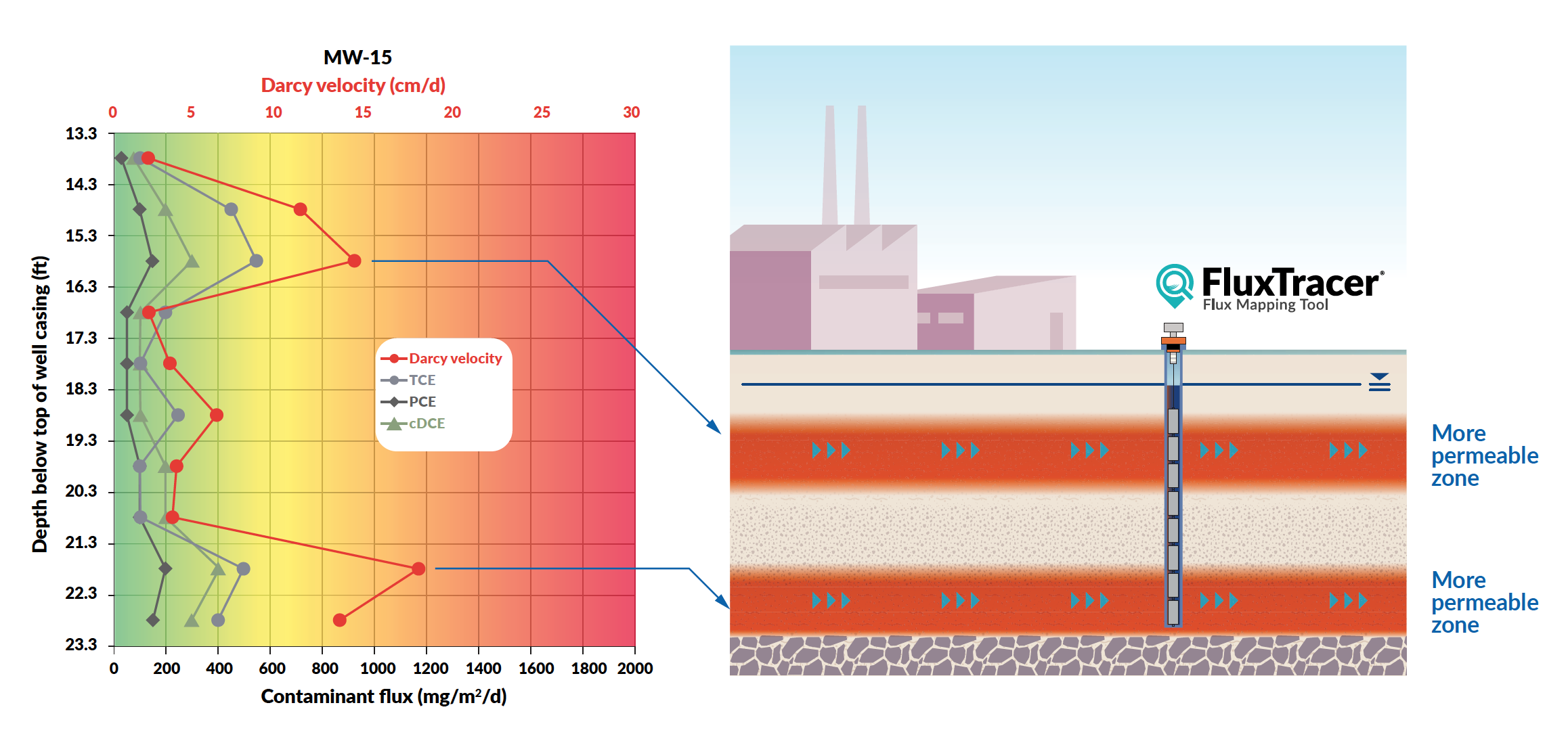
Frequently Asked FluxTracer Questions
What is mass flux, and why is it crucial in environmental remediation?
Mass flux refers to the rate at which contaminants are moving across an aquifer perpendicular to the groundwater flow direction. Mass flux is measured as mass/area/time (mg/m2/day). Understanding mass flux is essential as it helps quantify the actual movement of contaminants, enabling accurate assessment of contamination severity, identification of high-risk zones, and more effective design of remediation strategies.
Why design remediation efforts based on mass flux rather than concentration alone?
Concentration data alone might not reveal the full extent of contaminant movement and risks. Mass flux considers both concentration and flow rate, providing a more comprehensive understanding of how contaminants are spreading through the subsurface. Designing remediation based on mass flux allows for targeted treatment, focusing efforts where contaminants pose the most significant risks.
Can FluxTracer data assist in regulatory compliance and stakeholder communication?
Yes, understanding mass flux through FluxTracer data provides robust scientific evidence that can support regulatory compliance efforts. Moreover, clear insights into contaminant movement derived from FluxTracer data can enhance stakeholder communication by providing transparent and actionable information about the remediation process.
How does FluxTracer ensure accurate characterization and dosing, leading to more effective remediation?
By providing detailed information on groundwater flow and contaminant mass movement, FluxTracer facilitates precise characterization of contamination zones. This data-driven approach enables accurate dosing of remediation products, ensuring that treatment efforts are tailored to the specific needs of the site for maximum effectiveness.
Can FluxTracer estimate the longevity of permeable barriers, optimizing their effectiveness?
Absolutely, FluxTracer’s precise data on groundwater mass flux helps in evaluating the performance and lifespan of permeable barriers. By monitoring contaminant movement over time, it assists in estimating the barrier’s longevity, allowing for proactive planning and optimizing their effectiveness throughout the remediation process.
What is FluxTracer and how does it work?
FluxTracer is a cutting-edge technology tailored for mapping contaminant mass flux and groundwater velocity within monitoring wells. Using passive sampling, it collects groundwater samples over time, allowing for a detailed analysis that precisely quantifies contaminant mass movement and groundwater flow rates in subsurface environments.
What are the key benefits of employing FluxTracer technology in environmental remediation?
FluxTracer’s distinctive advantages encompass high data resolution and accuracy, enabling effective plume characterization and reliable turnaround times. Its precise measurements facilitate a detailed understanding of contaminant behavior, empowering professionals to design targeted and efficient remediation strategies.
Is any on-site assembly needed for FluxTracer deployment?
No, FluxTracers are delivered pre-assembled and ready for immediate deployment upon arrival. This streamlined approach eliminates on-site assembly requirements, ensuring a hassle-free setup process.
How does FluxTracer assist in remediation designs?
FluxTracer plays a pivotal role in identifying impacted zones, estimating the longevity of remediation products, and devising more effective and targeted remediation strategies. Its detailed data helps in precisely delineating contamination areas and optimizing treatment plans accordingly.
What limitations of conventional methods does FluxTracer address?
Conventional methods often fall short in accurately estimating velocities within flux zones. FluxTracer’s advanced technology overcomes these limitations by providing detailed and nuanced data, ensuring a more accurate depiction of groundwater movement and contaminant behavior.
How does FluxTracer measure groundwater mass flux and why is it beneficial?
FluxTracer utilizes passive sampling technology to collect groundwater samples over time. By analyzing these samples, FluxTracer accurately determines contaminant concentrations and flow rates, providing precise data on groundwater mass flux. This information aids in creating detailed site conceptual models and optimizing remediation designs.
How does understanding mass flux impact the effectiveness of remediation strategies?
Designing with mass flux allows remediation efforts to target high-flux zones, where contaminants are moving most rapidly. By addressing these areas, remediation strategies become more efficient and can significantly reduce the overall spread of contamination, leading to faster and more effective cleanup.
How does FluxTracer help in minimizing reapplication of in-situ remediation products, expediting project completion?
FluxTracer precisely measures groundwater mass flux, enabling accurate characterization of contaminant movement. This data ensures optimized dosing and targeted treatment, reducing the need for excessive product reapplication. Consequently, projects progress faster due to efficient and focused remediation efforts.
How does FluxTracer guarantee accurate product placement, ensuring contact with contaminant zones?
FluxTracer’s ability to measure mass flux aids in identifying high-flux areas where contaminants are moving most rapidly. This information guides the strategic placement of remediation products, ensuring they effectively target and make contact with the contaminant zones, maximizing treatment efficiency.
How does FluxTracer's technology contribute to cost savings and overall project efficiency?
FluxTracer’s ability to provide accurate and detailed data on contaminant movement and flow rates allows for targeted and efficient remediation efforts. This targeted approach minimizes unnecessary treatments, reduces reapplications, and optimizes the use of remediation products and barriers, leading to cost savings and faster project completion.
How does FluxTracer differ from conventional methods such as pump and slug tests?
Unlike pump and slug tests that provide singular measurements, FluxTracer stands out by offering high-resolution data that reveals variations across different zones within an aquifer. This detailed resolution allows for a comprehensive understanding of contaminant movement, providing a more nuanced view of the site’s dynamics.
How long does the installation of FluxTracer take?
Installing FluxTracer is a swift process, typically requiring only about 15 minutes per device. This quick installation time ensures minimal disruption to ongoing site activities, expediting the commencement of monitoring and data collection.
What contaminants can FluxTracer effectively target?
FluxTracer is proficient in detecting a range of contaminants, including Chlorinated Volatile Organic Compounds (CVOCs), PFAS, and other hazardous substances. Its versatility in targeting various contaminants makes it a valuable tool in different remediation scenarios.
How does FluxTracer contribute to understanding groundwater velocity for effective remediation?
FluxTracer furnishes high-resolution data critical for understanding groundwater velocity, which is essential for designing and implementing in-situ remediation strategies. Its precise measurements of groundwater movement guide the development of targeted and efficient remediation plans.
Can FluxTracer measure groundwater flow direction?
No, FluxTracer devices are designed specifically for quantifying contaminant mass flux and groundwater velocity within monitoring wells. Determining groundwater flow direction requires additional site-specific information and traditional groundwater level/elevation data analysis by qualified environmental professionals. For precise determination of flow direction, engineers integrate FluxTracer data with other site-specific hydrogeological information and tools to comprehensively assess groundwater dynamics.

 Americas
Americas Europe
Europe Français
Français Deutsch
Deutsch Italiano
Italiano Español
Español
